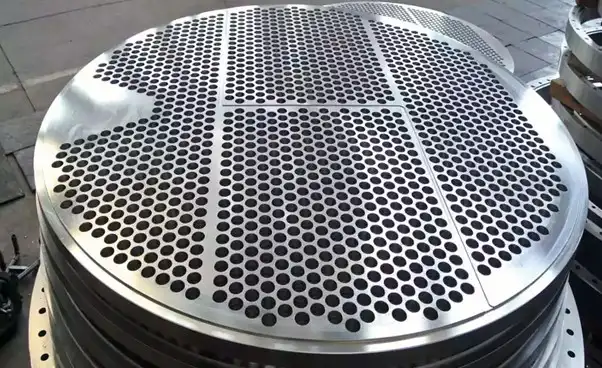Ethylene Quench Tower Corrosion Mitigation Saves $1.8Mil
HVTS Mitigates Corrosion in Ethylene Quench Tower
Quench towers involved in the Ethylene production processes require robust corrosion-resistant solutions due to corrosion, erosion-corrosion and fluid flow enhanced corrosion mechanisms. In this case study, we delve into the challenges faced by a prominent petrochemical company in the Middle East, and how they successfully addressed corrosion issues in their ethylene quench tower.
Asset Owner Overview
This company has emerged as one of Middle East’s leading petrochemical giants. Their ethylene production facility faced a critical challenge in the form of fluid flow enhanced corrosion in the quench tower’s stainless steel-cladded surfaces and the adjacent baffle plate manufactured from stainless steel.
Initial Challenge – Corrosion in the Ethylene Quench Tower
Ethylene plant’s quench tower experienced erosion-corrosion in the bottom conical section and the front face of the perforated baffle plate. The challenge lay in addressing erosion primarily in the bottom section due to the higher flow and turbulence. The baffle plate, a solid stainless steel component, faced erosion-corrosion, particularly on its front face exposed to the corrosive process stream.
To combat this, in 2014, the plant opted for a High Velocity Thermal Spray (HVTS) solution, achieving lasting results.


Repeated Success of High Velocity Thermal Spray and Expansion of Service
The initial HVTS application proved highly effective. In 2020, the plant invited the IGS (Integrated Global Services) experts back for another HVTS application due to changes in the quench tower’s components. Plates were replaced, new sections added and HVTS was used to protect components from metal degradation.
HVTS Formulation
The applied HVTS comprised a nickel-chrome moly-tungsten carbide combination, modified for large infield thermal spray applications. The base alloy, Hastelloy C-276, underwent adjustments to ensure consistent properties reducing residual stresses.
Alternative Solutions
Without HVTS, the alternatives were limited. Weld overlay on stainless steel cladded plates was a possibility, but the perforated nature of the baffle plate made this impractical. HVTS stood out for its speed and proven past performance.
Return on Investment for HVTS Application
Quantifying the return on investment, especially in time savings, was challenging. A hypothetical comparison with weld overlay, considering HVTS being three times faster, hinted at significant gains. The plant’s decision to choose HVTS for more applications in the same quench tower almost a decade later showcased their confidence in its efficiency.
Predicted Commercial Benefits of $1.8Mil
Estimating potential losses during downtime, assuming a daily production value of approximately 300,000 USD from the quench column and considering a 6-day difference between HVTS and alternative methods, suggested potential savings of 1.8 million USD were realized.

Conclusion of another successful HVTS application
This ethylene plant’s proactive approach in combating ethylene quench tower corrosion with HVTS showcases the efficacy of this solution in extending equipment lifespan, reducing downtime, and delivering substantial cost savings. This case study underlines the importance of innovative corrosion mitigation strategies for the longevity of critical petrochemical infrastructure.
Related Case Studies:
- TubeTech™ Reinstates Heat Transfer Efficiency of an Ethylene Furnace
- Ethylene Furnace Throughput Increase
- Column Shell Corrosion Protection Verified
- H2S and CO2 Gas Vessels 10+ Years in Service
- H2S Corrosion in an Upstream Separator Vessel Permanently Stopped
- HVTS Stops Sour Water Stripper Corrosion
On-site Thermal Spray Coating Services from IGS:
Free consultation with an IGS Subject Matter Expert
IGS is here to provide information, answer questions and create an effective solution for your needs.

